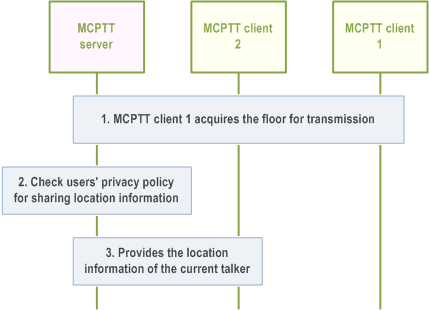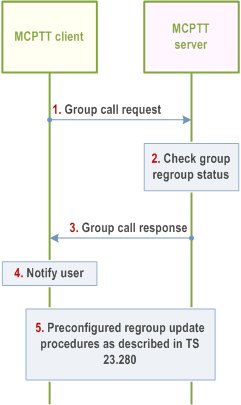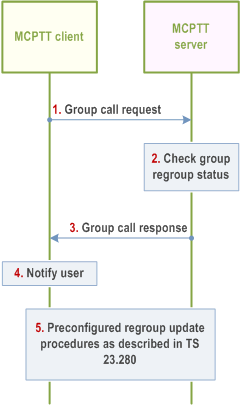Content for TS 23.379 Word version: 19.2.0
1…
7…
7.4…
10…
10.5…
10.6…
10.6.2.2.13…
10.6.2.2.24…
10.6.2.3…
10.6.2.3.1.2…
10.6.2.3.2…
10.6.2.4…
10.6.2.4.3…
10.6.2.5…
10.6.2.5.2.3…
10.6.2.6…
10.6.2.6.2…
10.6.2.7…
10.6.2.10…
10.6.3…
10.7…
10.7.2.2…
10.7.2.3…
10.7.3…
10.7.4…
10.7.5…
10.7.5.2.3a…
10.7.6…
10.7.6.2.3…
10.9…
10.9.1.3…
10.9.1.3.2…
10.9.1.3.3…
10.9.1.4…
10.9.1.5…
10.9.2…
10.9.2.6…
10.10…
10.12…
10.14…
10.15…
10.19…
10.19.2.11…
10.19.3…
10.19.3.1.4…
10.19.3.2…
10.19.3.2.4…
10.19.3.2.6…
A…
A.4…
B…
10.6.2.7 Location of current talker
10.6.2.9 Group call handling with preconfigured regroup update
10.6.2.9.3 Regroup procedures in multiple MCPTT systems
10.6.2.9.5 Procedures
10.6.2.9.5.1 Call request to an MCPTT group during an in-progress preconfigured group regroup
10.6.2.9.5.2 Call request to a preconfigured regroup group after group regroup has been cancelled
...
...
10.6.2.7 Location of current talker p. 92
Figure 10.6.2.7-1 shows the high level procedure to for MCPTT service to provide the location information about the current talking user to all the receiving MCPTT users.
Precondition:
- There is on-going group call involving MCPTT client 1 and MCPTT client 2.
- MCPTT client 1 is the current talking user.
- MCPTT server has obtained the location information of MCPTT client 1 according to subclause 10.9 in TS 23.280.

Step 1.
MCPTT client 1 gets the floor to transmit voice media.
Step 2.
MCPTT server checks the privacy policy (authorisation to provide location information to other MCPTT users on a call when talking, as defined in Annex A.3) of the current talking MCPTT user to decide if the location information of MCPTT client 1 can be provided to other MCPTT users on the call. MCPTT server acquires the location of the current talker from the location management server as described in subclause 10.9.3.6 of TS 23.280. Optionally, the MCPTT server acquires the location of the current talker directly from the floor request received from MCPTT client 1 in step 1.
Step 3.
MCPTT server provides the location information of MCPTT client 1 to MCPTT client 2. Optionally, the location information may be provided in the floor taken message sent to MCPTT client 2 according to subclause 10.9.1.3.1.
10.6.2.8 Void
10.6.2.9 Group call handling with preconfigured regroup update |R16| p. 94
10.6.2.9.1 Void
10.6.2.9.2 Void
10.6.2.9.3 Regroup procedures in multiple MCPTT systems p. 94
10.6.2.9.4 Void
10.6.2.9.5 Procedures p. 94
10.6.2.9.5.1 Call request to an MCPTT group during an in-progress preconfigured group regroup p. 94
Figure 10.6.2.9.5.1-1 illustrates the procedure when a user attempts to setup an MCPTT group call on a group involved in an in-progress preconfigured MCPTT group regroup.
Pre-conditions:
- The MCPTT client is an affiliated member of MCPTT group A that is part of an in-progress preconfigured group regroup with MCPTT groups B and C.
- MCPTT group D is being used as the preconfigured regroup group.
- The MCPTT client has missed the preconfigured regroup request message (e.g. poor signalling conditions, race condition).

Step 1.
The MCPTT client attempts to start a call on MCPTT group A. The MCPTT client sends a group call request message to the MCPTT server containing MCPTT group A as the target group.
Step 2.
The MCPTT server checks to see whether MCPTT group A is currently part of a preconfigured group regroup. In this case the group A is part of an active preconfigured group regroup.
Step 3.
The MCPTT server sends a group call response to the MCPTT client indicating that the call setup is denied because the group is part of an in-progress group regroup.
Step 4.
The MCPTT client notifies the user of the group call setup failure.
Step 5.
The MCPTT server initiates the adding a user to regroup group due to communication request to the group being regrouped procedure as described in clause 10.15.3.4 of TS 23.280.
10.6.2.9.5.2 Call request to a preconfigured regroup group after group regroup has been cancelled p. 95
Figure 10.6.2.9.5.2-1 illustrates the procedure when a user attempts to setup a MCPTT group call on a preconfigured regroup group after the preconfigured MCPTT group regroup has been cancelled.
Pre-conditions:
- The MCPTT client is a member of MCPTT group A that was part of an in-progress preconfigured group regroup with MCPTT groups B and C that has been cancelled. MCPTT group D was used as the MCPTT regroup group.
- The MCPTT client has missed the preconfigured regroup cancel request message (e.g. poor signalling conditions, race condition).

Step 1.
The MCPTT client attempts to start a call on MCPTT group D, the MCPTT regroup group. The MCPTT client sends a group call request message to the MCPTT server containing MCPTT group D as the target group.
Step 2.
The MCPTT server checks to see whether MCPTT group D is currently being cancelled or not. In this case the regroup group D is no longer active.
Step 3.
The MCPTT server sends a group call response to the MCPTT client indicating that the call setup is denied because the regroup group D is no longer active.
Step 4.
The MCPTT client notifies the user of the group call setup failure.
Step 5.
The MCPTT server initiates the regroup group cancel notification due to communication request to the cancelled regroup group as described in clause 10.15.3.4 of TS 23.280.